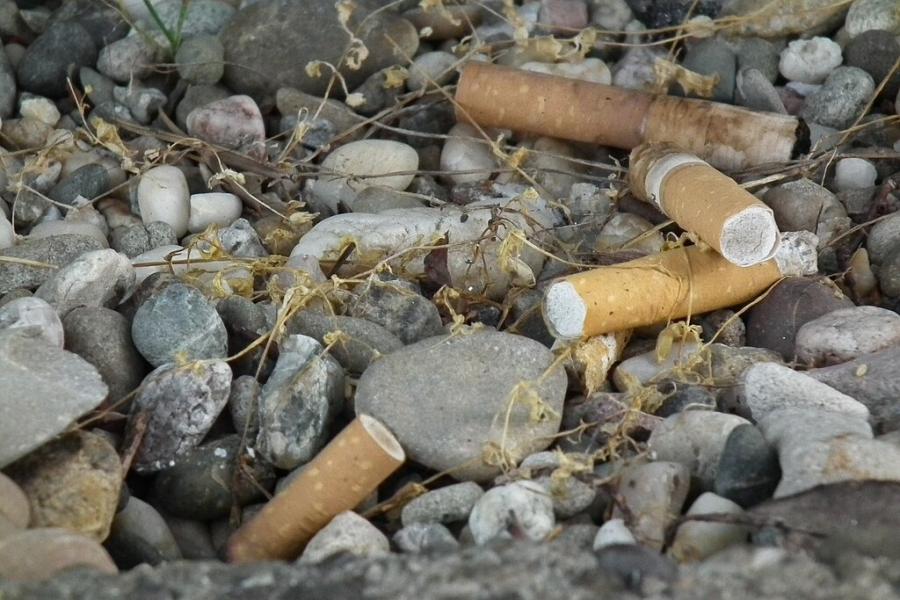Tobacco causes a long list of well-known health issues, from cancer and diabetes to stroke and lung disease. But this addictive substance is also wreaking havoc on the environment.
One of the most visible issues? Tobacco product litter, which makes up 25% to 40% of all litter globally, according to the World Health Organization.
Two new studies from the Johns Hopkins Institute for Global Tobacco Control point to some possible solutions that could help curb tobacco's human health and environmental effects simultaneously, including banning cigarette filters and requiring manufacturers to pay for clean-up efforts.
"We can't be healthy without a healthy environment," says Ryan Kennedy, an associate professor in the Department of Health, Behavior and Society who co-authored one of the new studies.
Environmental consequences of tobacco
An estimated 1.25 billion adults around the world use some form of tobacco. And when they're done smoking or chewing, many simply toss their cigarette butts or smokeless tobacco packaging onto the ground.
Roughly 4.5 trillion cigarette butts are littered every year, making them the most littered item on the planet, according to WHO. That's particularly problematic because most cigarette butts contain filters, which are made of nonbiodegradable plastic and contain toxic chemicals that leach into the soil and water. The tobacco industry has historically marketed filtered cigarettes as healthier—despite the overwhelming majority of research suggesting otherwise.
Beyond litter, tobacco harms the environment in other ways, such as requiring forests to be cleared to make room for tobacco farms and using charcoal to cure tobacco leaves.
"We talk a lot about the impact of tobacco growing, but there has been more discussion of the environmental impacts of tobacco at every stage, including production and use," says Graziele Grilo, who co-authored both studies and serves as program officer for the Institute for Global Tobacco Control. "Now we are also seeing that, post-use, there is a huge environmental impact, too."
Understanding tobacco product litter
Against this backdrop, Johns Hopkins researchers and collaborators set out to better understand the problem of tobacco product litter in India and Brazil.
For one study, they visited nine cities in India and walked 250-meter street sections in search of tobacco litter. In 135 total observations—including some near schools—they found more than 17,000 pieces of tobacco product litter, including smokeless tobacco packaging and cigarette butts.
"This waste is ubiquitous," Kennedy says. "Not only did we find tobacco product waste on every single one of those transects we walked, but we found every type of litter as well."
Brand names and logos were still visible on the vast majority—81%—of the litter they saw. This is what's known as "post-consumption marketing," or advertising that continues after a product is used and reaches people who do not use the product.
Since cigarette butt litter is so common, this free, additional promotion likely contributes to the perception that using tobacco is socially acceptable—and researchers argue it should be regulated. Policymakers could require all tobacco makers to use plain, standardized packaging, for instance.
"We have so many restrictions on when and where tobacco companies can advertise, and we know globally that we need to restrict opportunities for the industry to promote their products, especially among young people," says Kennedy. "The person using the cigarette doesn't need it, so who is that branding for? We think it's a clear decision to market those materials in the environment."
During a separate study in Brazil, researchers collected 4,300 cigarette butts from public sidewalks in the coastal city of Guarujá at a density of roughly one cigarette butt every five square meters. Laboratory testing showed they were causing severe pollution—as defined by the Cigarette Butts Pollution Index—by leaking a wide array of toxic contaminants into the environment.
Brand names and logos were also visible on more than 80% of the cigarette butts they found. Since some tobacco products are banned in Brazil, this allowed the researchers to clearly distinguish between licit and illicit products: They estimate between 22% and 37% of their sample was either smuggled in or produced illegally.
The branding on littered cigarette butts could not only help enforcement agencies crack down on the illicit tobacco trade, but it could be used to hold the industry accountable. In San Francisco, for example, all cigarette retailers must pay a $1.50 litter abatement fee for every pack they sell—and this type of policy could be implemented around the globe, the researchers argue.
Suggesting new solutions
Both studies make the case for banning filters, which would not only keep single-use plastics out of the environment—similar to bans on straws and disposable grocery bags—but would also remove a deceptive marketing tool from Big Tobacco's toolboxes.
Also see
"There has been a misperception that filters make cigarettes safer, which is not only not true from the user perspective but also for the environment," Grilo says.
More broadly, the two studies suggest a new focus for health promotion campaigns. In addition to messaging around tobacco's harmful health effects, public health practitioners may want to spotlight its environmental impact, which could help them reach different audiences.
"Young people might not have the same concerns about their future health, but they might care a lot about the environment," Kennedy says. "It speaks to the need for us to be creative about what and how we engage not only with policymakers but also with the people whose behaviors we want to support."
Posted in Health
Tagged tobacco control, institute for global tobacco control, environment, e-cigarettes, environmental health








